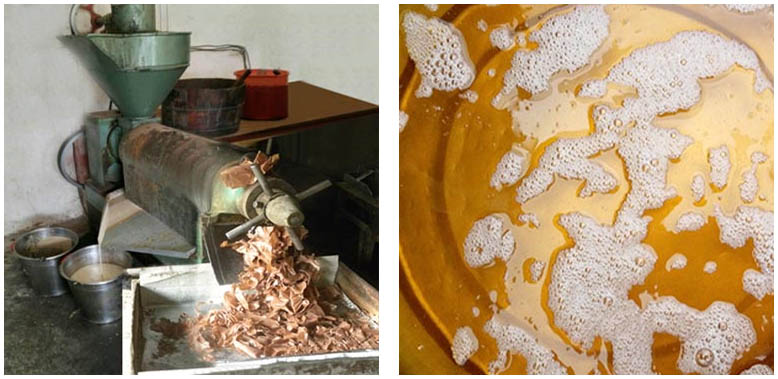What is pressed peanut oil
Pressed peanut oil and peanut dregs can be obtained through crushing, selecting (peanut kernel and shell separation), stir-frying to six to eight mature and physical pressing of peanut oil press. The peanut dregs are edible. The peanut oil press has two types: vertical oil overhead press machine and screw oil press.
Peanut oil is in light yellow and transparent. With clear color, fragrant smell and delicious taste, peanut oil is a kind of edible oil that is easy to digest. It contains more than 80% of unsaturated fatty acids (including 41.2% oleic acid and 37.6% of linoleic acid). In addition, it also contains 19.9% of saturated fatty acids, such as palmitic acid, stearic acid and arachidic acid.
From the above content, the fatty acid composition of peanut oil is better and easy to be digested and absorbed. According to the foreign data, the use of peanut oil can make the cholesterol in the body break up into bile acid and discharge out of the body, thus reducing the amount of cholesterol in plasma. In addition, the peanut oil also contains sterol, wheat germ phenol, phospholipid, vitamin E, choline and other substances beneficial to human body. Regular consumption of peanut oil can prevent skin wrinkle and aging, protect blood vessel wall, prevent thrombosis, arteriosclerosis and coronary heart disease. The choline in peanut oil can also improve the brain’s memory and slow brain function decline.

The peanut oil machine include press electrical rings for heating chamber, vacuum filter for oil filtration. After pressing and filtering, we can get pure oil from materials. Lower temperature start work only 50 degrees. The peanut oil pressing machine can save labor power and simplify the processing step.
The storage of peanut oil
1. The storage characteristics of peanut oil
Automatic oxidative rancidity of peanut oil would appear under general storage conditions with the following changes: the automatic oxidation process is associated with the season. If the storage begins in winter, the low temperature can effectively alleviate the effect of lipase and oxygen. With the change of season and rise of temperature, when the temperature is between 15°C to 30°C, the oil would hydrolyze and the acid value rises due to the lipolytic enzyme on the one hand; on the other hand, the immersion of oxygen in air would prompt oil oxidation and form hydroperoxide.
In summer, the room temperature and tank temperature would exceed 30°C. If stored in open-air oil tank or open storage ground and exposed to the sun, environmental factors would make the oil oxidation process accelerated. Especially under the action of ultraviolet (uv) or metal catalyst in the sun, when the radiation temperature is more than 50°C, peroxide and hydroperoxide would be further decomposed: molecular rearranges into aldehyde and ketone, which would lead to oil rancidity.
2. The storage measures of peanut oil
(1) Temperature: fill the container with peanut oil for airtight storage with the temperature below 15°C, otherwise, the lipolytic enzyme and oxygen would react with oil that the acid value and peroxide value would increase. Thus, it should meet the storage conditions. The oil storehouse should be built underground, because the ground temperature in 4 meters below is below 20°C throughout the year.
(2) For long-term storage of peanut oil, 0.2% of citric acid or ascorbic acid can be added to destroy the catalytic action of metal ions and prolong the storage period.
Pressed peanut oils have been a common cooking oil in south India for the past few centuries until it was replaced by refined oils about a decade ago. Peanut oil that is extracted using traditional cold pressed methods is highly nutritious and healthy with all the health benefits intact.
